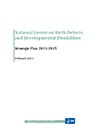Our Strategic Plan Priorities

As the National Center on Birth Defects and Developmental Disabilities (NCBDDD) begins its second decade, we thought an in-depth reflection of what we have accomplished, how we have operated, and what we want to accomplish in the next few years was in order. This strategic planning process has allowed us to accomplish this work, and most importantly, to identify promising new areas ripe for active engagement. In creating this plan, we identified our priorities by focusing on issues that share these characteristics:
- The magnitude of the problem is known and significant.
- Opportunities for prevention, intervention and improvement are present.
- Several conditions can be improved based on evidence-based interventions and strategies.
- Disparity reduction/amelioration is a central aspect of what we work to accomplish.
- The priorities are reinforced or supported by CDC-wide priorities, and clearly fit within our Center’s mandate.
- The priorities build on previous work or known scientific evidence.
Our strategic planning discussions confirmed that, in carrying out our work, NCBDDD strives to:
- Characterize the problem, incidence, prevalence, and distribution of our Center’s priority health conditions to inform public health research, priority setting and program monitoring;
- Conduct epidemiological research to understand the major modifiable risk factors in order to develop intervention/prevention programs and policies; and
- Develop, evaluate and disseminate effective programs and policies for adoption by global, national, state and local organizations.
Success in these population-based activities will result in:
- Prevention of birth defects and developmental disabilities;
- Health promotion and inclusion of people with disabilities;
- Prevention of chronic disease and subsequent mortality in people with our targeted conditions;
- Effective population level management of a number of existing conditions including blood disorders; and,
- Preparedness for disasters and other potential catastrophic health events.

Center Priorities
Priority 1: Enhancing the monitoring and tracking of autism and other developmental disabilities and advancing research into the risk factors for these conditions.
Priority 2: Preventing major birth defects associated with maternal risk factors.
Priority 3: Preventing death and disability associated with Venous Thromboembolism (VTE).
Priority 4: Preventing and controlling complications from hemoglobinopathies, like sickle cell disease (SCD) and thalassemia.
Priority 5: Identifying and reducing disparity in key health indicators, including obesity, among children, youth and adults with disabilities.
Priority 6: Incorporate disability status as a demographic variable into all relevant CDC surveys, policies, and practices.
Division Priorities
Division of Birth Defects and Developmental Disabilities
Priority 1: Enhancing the monitoring and tracking of autism and other developmental disabilities and advancing research into the risk factors for these conditions.
Priority 2: Preventing major birth defects associated with maternal risk factors.
Priority 3: Preventing fetal alcohol spectrum disorders and other negative effects of alcohol-exposed pregnancies.
Priority 4: Reducing folic acid-preventable neural tube defects.
Priority 5: Enhancing the quality and usefulness of newborn screening data and programs.
Division of Blood Disorders
 Priority 1: Preventing clotting disorders – venous thromboembolisms, deep vein thrombosis, and pulmonary embolism.
Priority 1: Preventing clotting disorders – venous thromboembolisms, deep vein thrombosis, and pulmonary embolism.
Priority 2: Preventing and controlling complications from hemoglobinopathies.
Priority 3: Preventing and controlling complications resulting from bleeding disorders.
Division of Human Development and Disability
Priority 1: Identifying and reducing disparity in key health indicators, including obesity, among children, youth and adults with disabilities.
Priority 2: Reducing disparities in health care access for people with disabilities
Priority 3: Improving developmental outcomes of children.
Priority 4: Ensuring that all newborns are screened and assessed for hearing loss and receive appropriate intervention.
Priority 5: Incorporating disability status as a demographic variable into all relevant CDC surveys, policies, and practices.
Contact Us:
- Centers for Disease Control and Prevention
National Center on Birth Defects and Developmental Disabilities
1600 Clifton Road
MS E-87
Atlanta, GA 30333 - 800-CDC-INFO
(800-232-4636)
TTY: (888) 232-6348
New Hours of Operation
8am-8pm ET/Monday-Friday
Closed Holidays - cdcinfo@cdc.gov
 NCBDDD Strategic Plan 2011-2015 (988 kb)
NCBDDD Strategic Plan 2011-2015 (988 kb)


